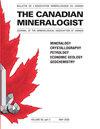Spatial Association Between Platinum Minerals and Magmatic Sulfides Imaged with the Maia Mapper and Implications for the Origin of the Chromite-Sulfide-PGE Association
IF 1.5
4区 地球科学
Q3 MINERALOGY
引用次数: 7
Abstract
The spatial association between Pt minerals, magmatic sulfides, and chromite has been investigated using microbeam X-ray fluorescence (XRF) element mapping and the Maia Mapper. This lab-based instrument combines the Maia parallel energy dispersive (ESD) detector array technology with a focused X-ray beam generated from a liquid metal source. It proves to be a powerful technique for imaging Pt distribution at low-ppm levels on minimally prepared cut rock surfaces over areas of tens to hundreds of square centimeters, an ideal scale for investigating these relationships. Images of a selection of samples from the Bushveld Complex and from the Norilsk-Talnakh ore deposits (Siberia) show strikingly close association of Pt hotspots, equated with the presence of Pt-rich mineral grains, with magmatic sulfide blebs in all cases, except for a taxitic low-S ore sample from Norilsk. In all of the Bushveld samples, at least 75% of Pt hotspots (by number) occur at or within a few hundred microns of the outer edges of sulfide blebs. In samples from the leader seams of the UG2 chromitite, sulfides and platinum hotspots are also very closely associated with the chromite seams and are almost completely absent from the intervening pyroxenite. In the Merensky Reef, the area ratio of Pt hotspots to sulfides is markedly higher in the chromite stringers than in the silicate-dominated lithologies over a few centimeters either side. We take these observations as confirmation that sulfide liquid is indeed the prime collector for Pt and, by inference, for the other platinum group elements (PGEs) in all these settings. We further propose a mechanism for the sulfide-PGE-chromite association in terms of in situ heterogeneous nucleation of all these phases coupled with transient sulfide saturation during chromite growth and subsequent sulfide loss by partial re-dissolution. In the case of the amygdular Norilsk taxite, the textural relationship and high PGE/S ratio is explained by extensive loss of S to an escaping aqueous vapor phase.用Maia Mapper成像的铂矿物和岩浆硫化物之间的空间关联及其对铬-硫化物PGE关联起源的启示
使用微束X射线荧光(XRF)元素图谱和Maia Mapper研究了Pt矿物、岩浆硫化物和铬铁矿之间的空间关联。这种基于实验室的仪器将Maia平行能量色散(ESD)探测器阵列技术与液态金属源产生的聚焦X射线束相结合。事实证明,这是一种强大的技术,可以在几十到几百平方厘米的区域内,以低ppm水平对最小制备的切割岩石表面上的Pt分布进行成像,这是研究这些关系的理想尺度。Bushveld杂岩和Norilsk Talnakh矿床(西伯利亚)精选样本的图像显示,Pt热点与岩浆硫化物气泡在所有情况下都有惊人的密切联系,相当于富含Pt的矿物颗粒的存在,但来自Norilsk的滑行低S矿石样本除外。在所有Bushveld样品中,至少75%的Pt热点(按数量计)出现在硫化物气泡外缘几百微米处或以内。在UG2铬铁矿主矿层的样品中,硫化物和铂热点也与铬矿层密切相关,并且几乎完全不存在于中间的辉石岩中。在Merensky Reef,铬铁矿细脉中Pt热点与硫化物的面积比明显高于两侧几厘米以上以硅酸盐为主的岩性。我们认为这些观察结果证实了硫化物液体确实是Pt的主要收集器,并且通过推断,在所有这些环境中,也是其他铂族元素(PGE)的主要收集器。我们进一步提出了硫化物-PGE-铬铁矿缔合的机制,即所有这些相的原位非均匀成核,以及铬铁矿生长过程中的瞬态硫化物饱和和随后的部分再溶解导致的硫化物损失。在淀粉状诺里尔斯克滑行岩的情况下,结构关系和高PGE/S比可以通过S大量损失到逸出的水蒸气相来解释。
本文章由计算机程序翻译,如有差异,请以英文原文为准。
求助全文
约1分钟内获得全文
求助全文
来源期刊

Canadian Mineralogist
地学-矿物学
CiteScore
2.20
自引率
22.20%
发文量
45
审稿时长
4-8 weeks
期刊介绍:
Since 1962, The Canadian Mineralogist has published papers dealing with all aspects of mineralogy, crystallography, petrology, economic geology, geochemistry, and applied mineralogy.
 求助内容:
求助内容: 应助结果提醒方式:
应助结果提醒方式:


